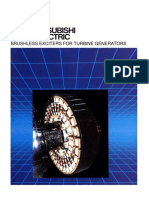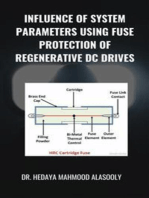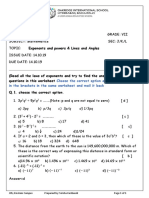0 ratings0% found this document useful (0 votes)
122 viewsEx180 Electric Motor Cooling
Ex180 Electric Motor Cooling
Uploaded by
electricalrakeshElectric Motor Cooling
Copyright:
Attribution Non-Commercial (BY-NC)
Available Formats
Download as PDF, TXT or read online from Scribd
Ex180 Electric Motor Cooling
Ex180 Electric Motor Cooling
Uploaded by
electricalrakesh0 ratings0% found this document useful (0 votes)
122 views2 pagesElectric Motor Cooling
Copyright
© Attribution Non-Commercial (BY-NC)
Available Formats
PDF, TXT or read online from Scribd
Share this document
Did you find this document useful?
Is this content inappropriate?
Electric Motor Cooling
Copyright:
Attribution Non-Commercial (BY-NC)
Available Formats
Download as PDF, TXT or read online from Scribd
Download as pdf or txt
0 ratings0% found this document useful (0 votes)
122 views2 pagesEx180 Electric Motor Cooling
Ex180 Electric Motor Cooling
Uploaded by
electricalrakeshElectric Motor Cooling
Copyright:
Attribution Non-Commercial (BY-NC)
Available Formats
Download as PDF, TXT or read online from Scribd
Download as pdf or txt
You are on page 1of 2
A P P L I C A T I O N B R I E F S F R O M F L U E N T
EX180
Electric Motor Cooling
The cooling of an electric motor is studied in this example. The motor consists of rotating and
stationary parts. It heats up because of heat transfer from the engine to which it is mounted and
because of frictional heating in the shaft bearings. Cooling is accomplished by coils mounted in the
housing and to a lesser degree by the air gap between the rotating and stationary components.
Results suggest that additional cooling is required for this particular motor and motor mount design.
The task of distributed letter "I". With the
power generation is exception of the
generally achieved by a stator, all solid motor
generator set consisting of components are
an internal combustion simulated as
(IC) engine coupled with conducting walls
an electric motor. Cooling (solid zones),
the electric motors is a throughout which the
challenging task. In energy equation is
addition to the heat solved.
released from the coils,
the motors receive The rotor is
additional heat flux from separated from the
the attached IC engine. motor housing and
The air gap, which is stator by an air gap
confined between the (blue). It contains a
rotor and stationary Figure 1: The motor geometry
components (stator and housing), Using FLUENT, a 30 degree
is generally very small and does periodic sector of the motor
not contribute significantly to the is analyzed. The calculation
cooling process. When this is the domain (Figure 1) consists
case, cooling water is circulated of the engine shaft, rotor,
through the coils in the motor stator, magnets, motor
housing to dissipate the heat. housing, and shaft and
housing adapters, which are
This example simulates one such used to bolt the motor to the
situation and predicts the heat engine. The stator, not
load distribution on various shown in the figure, lies
components of the electric motor. inside the rotor and housing,
The computational results provide extending from the region
detailed insight into the motor below the magnets to the
cooling process, and can be used region inside the outer
to guide the design of alternate portion of the motor
strategies for effectively cooling housing. It has a cross- Figure 2:Temperature
contours on the shaft
the motor. section with the shape of the and motor housing
Copyright © 2002 Fluent Inc. EX180 • Page 1 of 2
of conducting material (the (lower right) receive inadequate
gasket) between the external cooling compared to those
boundary (the engine) and the elsewhere.
fluid or conducting wall zones
(the adapters) on the interior of In summary, a CFD analysis of an
the domain. The circular bolt- electric motor mounted onto an IC
connecting surfaces are engine has shown that water coils
described by constant are effective in cooling only part
temperature boundary of the motor section - that which
conditions. The stator surfaces is more distant from the engine.
are treated as external Regions of the motor components
boundaries with a varying closest to the engine (magnets,
temperature in the radial rotor, and housing) showed
direction. consistently higher temperatures
due to direct heat influx through
A rotating zone is used to the adapters and frictional heating
simulate the motion of the in the bearings. The computational
rotor, shaft, bearing, and shaft results showed that additional
adapter. A hybrid mesh cooling or heat protection would
containing 1.5 million be necessary in the housing
tetrahedral and hexahedral adapters to avoid damage to the
Figure 3: Temperature contours on the rotor cells was created for the magnets on the engine side. In
simulation. addition, higher coolant flow
pair of magnets (red) that rotates through the engine side tube
with the rotor. The motor is bolted Figure 2 shows contours of would yield better cooling on the
to the engine using housing and temperature on the shaft and engine side of the motor.
shaft adapters. The bolts used to motor housing. The temperature
make the connections, with cross- contours illustrate the heat influx Courtesy of Lynx Motion
sections shown in green, transfer to these components from the Technology, Inc.
a significant amount of heat from engine. Contours of temperature (www.lynxmotiontechnology.com)
the engine to the motor. Gaskets on the rotor are shown
between the adapters and engine in Figure 3. Higher
mounts are used to minimize this temperature can be seen
heat transfer. at the lower right corner
(and to a lesser extent,
Convection heat transfer the lower left corner) of
boundary conditions are applied the rotor. This is mostly
on the exterior surfaces of the due to heating from the
housing. Cooling coils, mounted shaft adapter, and partly
in the engine housing, are also due to the heat source
modeled using this boundary that is included to
condition. Temperatures are represent frictional
specified on the adapter surfaces. heating at the site of the
The faces of the adapter surfaces shaft bearings.
that are covered with gaskets are Temperature contours on
modeled using the thin wall the magnets are shown
thermal resistance boundary in Figure 4. They
condition. This special boundary illustrate that the regions
condition allows for a thin layer closest to the engine Figure 4: Temperature contours on the magnets
Copyright © 2002 Fluent Inc. EX180 • Page 2 of 2
You might also like
- PDF Startup 1 Teachers Book CompressDocument180 pagesPDF Startup 1 Teachers Book CompressJoseph Boskc Mendoza100% (3)
- Mark Scheme (Results) : Pearson Edexcel International GCSE in Geography (4GE1) Paper 1: Physical GeographyDocument46 pagesMark Scheme (Results) : Pearson Edexcel International GCSE in Geography (4GE1) Paper 1: Physical GeographyShan Karunaratne50% (2)
- Enabling Objectives:: Introduction To CANDU Processes Module 3 - The Conventional Side of The StationDocument3 pagesEnabling Objectives:: Introduction To CANDU Processes Module 3 - The Conventional Side of The StationMohammad Ali Zaman0% (1)
- Study of a reluctance magnetic gearbox for energy storage system applicationFrom EverandStudy of a reluctance magnetic gearbox for energy storage system applicationRating: 1 out of 5 stars1/5 (1)
- Revision Assignment - CSS - Class VIIDocument3 pagesRevision Assignment - CSS - Class VIIDynamic Might67% (3)
- Icems 2019 8921961Document6 pagesIcems 2019 8921961Amir NazirNo ratings yet
- IECON_2006_BPMORDocument4 pagesIECON_2006_BPMORFarraen Mohd AzminNo ratings yet
- 6001b Failure QTR July-Sept PP 64-66Document3 pages6001b Failure QTR July-Sept PP 64-66Hernan Giraut100% (2)
- General Technical Information: Fans: CasingDocument35 pagesGeneral Technical Information: Fans: CasingpabloNo ratings yet
- Locomotive: Service ManualDocument31 pagesLocomotive: Service Manuallocomotoras1975No ratings yet
- UntitledDocument3 pagesUntitled권용수No ratings yet
- Fan Electric MotorDocument2 pagesFan Electric Motorluis eliseo victor huarache bellidoNo ratings yet
- Temperature Effects On DC Motor Performance 1Document10 pagesTemperature Effects On DC Motor Performance 1BabuNo ratings yet
- Temperature Effects On DC Motor Performance 1 PDFDocument10 pagesTemperature Effects On DC Motor Performance 1 PDFD RajeshNo ratings yet
- PT 9007 AmbientTempvsAOCDocument3 pagesPT 9007 AmbientTempvsAOCDiseñador WebNo ratings yet
- New Cooling System Design of BLDC Motor For Electric Vehicle Using Computation Fluid Dynamics ModelingDocument6 pagesNew Cooling System Design of BLDC Motor For Electric Vehicle Using Computation Fluid Dynamics ModelingKiran Kadam100% (1)
- Thermal Model For Induction MachineDocument5 pagesThermal Model For Induction MachineSiddhesh PanderkarNo ratings yet
- Choi2020 Article EnhancedEfficiencyOfTheBrushleDocument7 pagesChoi2020 Article EnhancedEfficiencyOfTheBrushleJohn XaviNo ratings yet
- Assessment of Axial Flux Motor Technology For Hybrid Powertrain IntegrationDocument8 pagesAssessment of Axial Flux Motor Technology For Hybrid Powertrain IntegrationRohith FleekzzsNo ratings yet
- Thermal Analysis of Induction and Synchronous Reluctance MotorsDocument6 pagesThermal Analysis of Induction and Synchronous Reluctance MotorsShraddha kaleNo ratings yet
- Design of PMSMDocument5 pagesDesign of PMSMrizwan hassanNo ratings yet
- Thermal_Modelling_of_a_High_Speed_Motor_SpindleDocument6 pagesThermal_Modelling_of_a_High_Speed_Motor_SpindleMinh Nhật LêNo ratings yet
- Power Generation With Solar Dish Stirling EngineDocument6 pagesPower Generation With Solar Dish Stirling EngineFaysal Abdul FattahNo ratings yet
- Research of The Inverse Time Characteristic Curve For The Electronic Thermal RelayDocument4 pagesResearch of The Inverse Time Characteristic Curve For The Electronic Thermal RelayGeorge MateiNo ratings yet
- AS3379130710630411457576162275Document8 pagesAS3379130710630411457576162275florin chisNo ratings yet
- LimitsDocument6 pagesLimitsDan Gray100% (1)
- Use of Electronic Viscous Drive To Decrease Fan Duty CycleDocument5 pagesUse of Electronic Viscous Drive To Decrease Fan Duty CycleTiếngHátĐêmNo ratings yet
- Generation of Electricity Using Fan PDFDocument4 pagesGeneration of Electricity Using Fan PDFAmruta KageNo ratings yet
- (INGILIZCE) Conceptual DesignDocument4 pages(INGILIZCE) Conceptual DesignnonkolmcNo ratings yet
- Calculation and Identification of A Thermal Equivalent Circuit of A Water Cooled Induction Motor For Ev AppDocument5 pagesCalculation and Identification of A Thermal Equivalent Circuit of A Water Cooled Induction Motor For Ev AppMirela VihacencuNo ratings yet
- Thermal Analysis of Air Cooled Synchronous Generator: Jehan ShazlyDocument8 pagesThermal Analysis of Air Cooled Synchronous Generator: Jehan ShazlyAnonymous q8EusUCNo ratings yet
- AGEN 180 Agricultural ElectrificationDocument5 pagesAGEN 180 Agricultural ElectrificationJojenNo ratings yet
- EV Motors and ControllersDocument112 pagesEV Motors and Controllersphumiphat.sNo ratings yet
- 300 KW Ceramic TurbineDocument6 pages300 KW Ceramic Turbinejr110livecomNo ratings yet
- FER-55-3-093-2009 Global VPI PDFDocument7 pagesFER-55-3-093-2009 Global VPI PDFFadhil NugrahaNo ratings yet
- Characterization of The Thermal Performances of Low-Cost Sub-Fractional Horsepower BLDC Claw-Pole Motor DesignsDocument7 pagesCharacterization of The Thermal Performances of Low-Cost Sub-Fractional Horsepower BLDC Claw-Pole Motor DesignsQuang Huy VũNo ratings yet
- Abe 150 Lab Report Manual Ex 01Document10 pagesAbe 150 Lab Report Manual Ex 01John Kennedy EvangelistaNo ratings yet
- Noise Source Identification of Small Fan-BLDC Motor System For RefrigeratorsDocument8 pagesNoise Source Identification of Small Fan-BLDC Motor System For RefrigeratorsmitulNo ratings yet
- Chapter Seven Heat Transfer in I. C. EnginesDocument16 pagesChapter Seven Heat Transfer in I. C. EnginesaliNo ratings yet
- Siemens SGen-1000A+Series Nov14Document4 pagesSiemens SGen-1000A+Series Nov14Jaylord CrisostomoNo ratings yet
- 2022-01-5067Document9 pages2022-01-5067UMUT CANVARNo ratings yet
- Heat Transfer in The Cylinder of A New Two-Stroke Cross-Scavenged EngineDocument7 pagesHeat Transfer in The Cylinder of A New Two-Stroke Cross-Scavenged EngineRajendra JadhavNo ratings yet
- ECEDocument4 pagesECEdurgesh patelNo ratings yet
- Mod 2 Vtu Notes HubDocument21 pagesMod 2 Vtu Notes Hubpiyush9199721998No ratings yet
- GeneratorDocument4 pagesGeneratorगुंजन सिन्हाNo ratings yet
- IRJET-V9I6484Document11 pagesIRJET-V9I6484official channelNo ratings yet
- Motor ProtectionDocument34 pagesMotor Protectionmanirup_tceNo ratings yet
- Various Two: Performance of Stator Salient Disc Brushless DC Motor For EvDocument4 pagesVarious Two: Performance of Stator Salient Disc Brushless DC Motor For EvAakarsh VermaNo ratings yet
- Engine Exhust Power Generasion System: Fig. 1 Seebeck EffectDocument5 pagesEngine Exhust Power Generasion System: Fig. 1 Seebeck EffectSajid ShaikhNo ratings yet
- WP GCC S en GS 01 0Document8 pagesWP GCC S en GS 01 0mohamadeisaNo ratings yet
- Stator Life of A Positive Displacement Downhole Drilling MotorDocument12 pagesStator Life of A Positive Displacement Downhole Drilling MotorMilad Ebrahimi DastgerdiNo ratings yet
- Yeh 2010Document7 pagesYeh 2010Quang Huy VũNo ratings yet
- 10 11648 J Ijecec 20150102 13-LibreDocument6 pages10 11648 J Ijecec 20150102 13-LibrelahcenamriNo ratings yet
- Taurus Ducted SplitDocument4 pagesTaurus Ducted SplitSrinivasan ThyagarajanNo ratings yet
- Design and Analysis of New Class Brushless DC Motor FSMDocument5 pagesDesign and Analysis of New Class Brushless DC Motor FSMKitaba TolesaNo ratings yet
- Design Considerations For Dual Winding Permanent Magnet Synchronous MachinesDocument8 pagesDesign Considerations For Dual Winding Permanent Magnet Synchronous MachinesEasthamNo ratings yet
- CEME308GeorgiaTech - Motor Prot HVDocument61 pagesCEME308GeorgiaTech - Motor Prot HVFernando MUNERA HOYOSNo ratings yet
- Eksitasi Generator ACDocument8 pagesEksitasi Generator ACUmmi Ulan Dari0% (1)
- Harmonic Analysis of DFIG Wind TurbineDocument11 pagesHarmonic Analysis of DFIG Wind TurbineInternational Journal of Innovative Science and Research TechnologyNo ratings yet
- Factors On Motor Selection & EffiencyDocument10 pagesFactors On Motor Selection & EffiencyRaushan Jha100% (1)
- Influence of System Parameters Using Fuse Protection of Regenerative DC DrivesFrom EverandInfluence of System Parameters Using Fuse Protection of Regenerative DC DrivesNo ratings yet
- A Case Study for a Single-Phase Inverter Photovoltaic System of a Three-Bedroom Apartment Located in Alexandria, Egypt: building industry, #0From EverandA Case Study for a Single-Phase Inverter Photovoltaic System of a Three-Bedroom Apartment Located in Alexandria, Egypt: building industry, #0No ratings yet
- Handbook of Electrical Engineering: For Practitioners in the Oil, Gas and Petrochemical IndustryFrom EverandHandbook of Electrical Engineering: For Practitioners in the Oil, Gas and Petrochemical IndustryNo ratings yet
- Auxiliary DC Power Supply For Distribution SubstationsDocument42 pagesAuxiliary DC Power Supply For Distribution SubstationselectricalrakeshNo ratings yet
- Bucholz RelayDocument4 pagesBucholz RelayMonish Nawal100% (1)
- Is 12615Document11 pagesIs 12615Amitava Paul50% (2)
- Electrical Switch GearDocument50 pagesElectrical Switch Gearmarkigldmm918No ratings yet
- Ehv Gis SubstationDocument6 pagesEhv Gis SubstationelectricalrakeshNo ratings yet
- Cable Insulation ResistanceDocument8 pagesCable Insulation ResistanceelectricalrakeshNo ratings yet
- Induction Motor Nameplate InformationDocument6 pagesInduction Motor Nameplate Informationelectricalrakesh100% (1)
- Technical Specification of 11Kv & 33Kv Oil Immersed CT:PT (Metering Equipment) UnitsDocument9 pagesTechnical Specification of 11Kv & 33Kv Oil Immersed CT:PT (Metering Equipment) Unitsrajeeb1985No ratings yet
- 1984 Introduction With MacroDocument21 pages1984 Introduction With MacropizzaguymeNo ratings yet
- The Protection of Civilians in United Nations PeacekeepingDocument238 pagesThe Protection of Civilians in United Nations PeacekeepingLuís ConceiçãoNo ratings yet
- Grade 7 Mathematics Holiday Task Sheet-1Document5 pagesGrade 7 Mathematics Holiday Task Sheet-1kavyaNo ratings yet
- Vda de Perez vs. ToleteDocument2 pagesVda de Perez vs. ToleteAnny YanongNo ratings yet
- Tutorial Letter 101/2013/3 Language TeachingDocument28 pagesTutorial Letter 101/2013/3 Language TeachingCharmaine Verrall57% (7)
- Judgments On Limitation On Behalf of ClaimantDocument72 pagesJudgments On Limitation On Behalf of Claimantasritamullapudi0211No ratings yet
- Sri Krishna Janmaashtami (Significance, Customs and Traditions)Document8 pagesSri Krishna Janmaashtami (Significance, Customs and Traditions)bhargavasarma (nirikhi krishna bhagavan)No ratings yet
- Everythursday - A Place Called Home (Rated NC-17)Document10 pagesEverythursday - A Place Called Home (Rated NC-17)Ashwerya NarulaNo ratings yet
- Learning OutcomesDocument10 pagesLearning OutcomesAyachitula Laxmana RaoNo ratings yet
- Eng2 6Document3 pagesEng2 6thakkardhruv022No ratings yet
- 30 Filipino Keto Desserts PDFDocument32 pages30 Filipino Keto Desserts PDFauqnah58100% (1)
- PPG - Module 3 - 2ND Sem - 2ND Quarter - Grade 11 - Humss Bonifacio-Agoncillo - MR - Paombong - MRS CuencaDocument12 pagesPPG - Module 3 - 2ND Sem - 2ND Quarter - Grade 11 - Humss Bonifacio-Agoncillo - MR - Paombong - MRS CuencaArnold PaombongNo ratings yet
- Characterization of Various Cement GA and Their Impact On Grindability and Cement PerformanceDocument6 pagesCharacterization of Various Cement GA and Their Impact On Grindability and Cement PerformanceNam HuynhNo ratings yet
- Clinical Anatomy 11e 11th Edition Harold Ellis 2024 scribd downloadDocument75 pagesClinical Anatomy 11e 11th Edition Harold Ellis 2024 scribd downloadkeywanalmala100% (6)
- Story Telling Competition Presentation 2024Document17 pagesStory Telling Competition Presentation 2024Win Myo ThantNo ratings yet
- Guest LectureDocument2 pagesGuest Lecturesatyam sarangiNo ratings yet
- CRM 4th Module (30 Marks)Document7 pagesCRM 4th Module (30 Marks)anjnaprohike26No ratings yet
- Article Review: Contextual Interpretation by Lakshmi JambholkarDocument7 pagesArticle Review: Contextual Interpretation by Lakshmi JambholkarRamasayi GummadiNo ratings yet
- Chapter 4: Filipino Characteristics: Pakikipagkapwa-TaoDocument3 pagesChapter 4: Filipino Characteristics: Pakikipagkapwa-TaoMaria VillanuevaNo ratings yet
- Case StudyDocument5 pagesCase Studylolnasi360No ratings yet
- Essay On Independence of NepalDocument2 pagesEssay On Independence of Nepallittle bunny foo fooNo ratings yet
- THT-TL Dress Code - Personal Hygiene Policy 2019Document6 pagesTHT-TL Dress Code - Personal Hygiene Policy 2019venkateshNo ratings yet
- Puducherry Draft Mobility Plan - PresentationDocument101 pagesPuducherry Draft Mobility Plan - PresentationNathar ShaNo ratings yet
- Kamiran Azeez M. GraviDocument8 pagesKamiran Azeez M. GraviKamiran GraviNo ratings yet
- Evaluation One Elementary1 JanuaryDocument8 pagesEvaluation One Elementary1 JanuaryCarlos MinanoNo ratings yet
- BiometricDocument20 pagesBiometriccalliezx13No ratings yet
- Class8 Science ReducedDocument204 pagesClass8 Science Reducedssdagur95No ratings yet

































































































